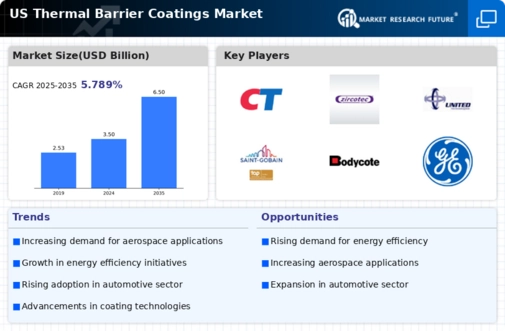The thermal barrier coatings market exhibits a dynamic competitive landscape characterized by innovation and strategic partnerships. Key players such as General Electric (US), Honeywell International (US), and Saint-Gobain (US) are at the forefront, leveraging their technological expertise to enhance product offerings. General Electric (US) focuses on advancing its coating technologies to improve thermal efficiency, while Honeywell International (US) emphasizes sustainability in its manufacturing processes. Saint-Gobain (US) is actively pursuing regional expansion to tap into emerging markets, thereby shaping a competitive environment that prioritizes innovation and operational excellence.
The market structure appears moderately fragmented, with several players vying for market share through localized manufacturing and optimized supply chains. This fragmentation allows for a diverse range of products and services, catering to various industrial applications. The collective influence of these key players fosters a competitive atmosphere where differentiation is achieved through technological advancements and customer-centric solutions.
In November 2025, General Electric (US) announced a partnership with a leading aerospace manufacturer to develop next-generation thermal barrier coatings aimed at enhancing engine performance. This strategic move underscores GE's commitment to innovation and positions it to capture a larger share of the aerospace sector, which is increasingly demanding high-performance materials. The collaboration is expected to yield significant advancements in coating durability and efficiency, aligning with industry trends towards more sustainable aviation technologies.
In October 2025, Honeywell International (US) launched a new line of eco-friendly thermal barrier coatings designed to reduce environmental impact while maintaining high performance. This initiative reflects Honeywell's strategic focus on sustainability, responding to growing regulatory pressures and customer demand for greener solutions. The introduction of these coatings not only enhances Honeywell's product portfolio but also strengthens its market position as a leader in environmentally responsible manufacturing practices.
In September 2025, Saint-Gobain (US) expanded its production capabilities by investing in a state-of-the-art facility dedicated to thermal barrier coatings. This investment is indicative of Saint-Gobain's strategy to enhance its manufacturing efficiency and meet the increasing demand from the automotive and aerospace sectors. By bolstering its production capacity, the company aims to solidify its competitive edge and respond swiftly to market fluctuations.
As of December 2025, the competitive trends in the thermal barrier coatings market are increasingly defined by digitalization, sustainability, and the integration of advanced technologies such as AI. Strategic alliances are becoming pivotal in shaping the landscape, enabling companies to pool resources and expertise for enhanced innovation. The shift from price-based competition to a focus on technological differentiation and supply chain reliability is evident, suggesting that future competitive advantages will hinge on the ability to innovate and adapt to evolving market demands.


















Leave a Comment